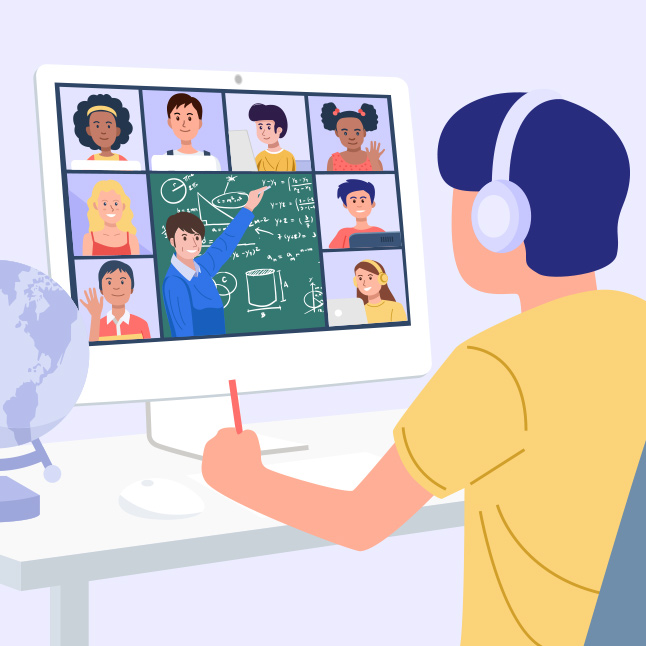How a Pandemic Changed Learning: Teaching In a Remote World

During an average school year, teaching can be difficult enough. Even in the best of times, teaching is full of early mornings, scrambling to manage dozens of hormonal students and long weekends packed with grading coursework. It is a job that is uniformly underappreciated, as society often fails to acknowledge the many sacrifices that teachers make to provide a quality education.
But this has been no average school year.
Ever since March 16, in which all Connecticut schools were closed for in-person learning, Manchester Public Schools has had to grapple with how to effectively roll out a modified and safe school format. While the 2020-2021 semester started with hybrid learning, which consisted of a mixture of in-person and remote learning, Superintendent of Schools Matt Geary announced that as of December 14, Manchester’s schools would temporarily be returning to full-time remote learning.
Regardless of the format, the past months of schooling have been particularly challenging for teachers and students alike. Both groups have had to learn how to balance academic responsibilities with their personal lives, all while dealing with the stress of our COVID-plagued world. This is a balance that many have struggled to find, according to Jennifer Vignone, a teacher in the English Department at Manchester High School.
“There isn’t much of a difference between us in-person and online,” Vignone said. “I see it in my student’s eyes; they are world weary.”

With both modified in-person and remote learning comes the need to change how materials are taught, as teachers now have far less actual facetime with their students (around “half as much time” as normal, according to Vignone). As a result of the continued expectation that educators teach as much classroom material as they would during a normal school year, many teachers have had to strip the more personalized or enjoyable aspects of their material in order to meet their mandated curriculum.
“There’s a hierarchy that dictates what us teachers do, and we’ve ended up having to suck the fun out of [school],” Vignone said. “I am genuinely concerned that as a society, we have lost sight of what education is.”
Although many high school-age students are able to keep up with their academic work, Vignone said many struggle to maintain interpersonal relationships with their fellow classmates. Since students often aren’t able to see their friends in-person, they have to rely on virtual forms of connection, such as videogames or social media, which instead only further isolates students from their peers.
“There is such a disconnect between students, especially for those who already lean on the shy side,” Vignone said. “We never taught them how to handle their feelings and the stress they are going through.”
“All of the adults in our schools are struggling enough as is,” Naidorf said. “You can only imagine what it is like for these teenagers who are trying to cope.”
A large portion of these struggles, especially for educators, comes as a result of the lack of flexibility that teachers are given when it comes to their actual classroom material. While teachers and students have been forced to adapt to change, Manchester Public Schools’ high-level administration has failed to allow teachers the ability to modify their curriculum to better educate their students via distance learning, Naidorf argued.

“The administration is pretty tone-deaf to change,” Naidorf said. “There were already significant gaps that were created in previous semesters, and our students were already falling behind. There was just no real accountability.”
While Manchester’s curriculum attempts to provide a more universal approach to schooling, in order to ensure that all students are receiving an equal education regardless of teacher, this approach can further challenge those who are not properly adjusting to remote learning. These academic struggles, compounded with the inability for students to spend quality in-person time with their social groups, is having a drastic impact on teen’s mental health, according to Naidorf.
“I’ve seen a lot of students suffering. There has been a significant toll on our teen’s mental health,” Naidorf said.
This is particularly concerning when paired with Connecticut’s ever-increasing number of youth who are suffering from mental illness. According to Mental Health America’s 2020 report on mental health, 13 percent of Connecticut’s youth experienced at least one major depressive episode throughout the year. In addition, according to the Hartford Courant, over 14,000 kids and teens visited the state’s mobile crisis program in 2019, nearly triple that of the 5,000 visits the state received in 2008.
In order to alleviate some of these stresses, the Town of Manchester offers a variety of programs for its youth. Manchester’s Youth Service Bureau Division provides a variety of youth programming, including support and intervention programs, and ECHN offers adolescent services for those suffering from severe mental illness. However, despite these resources, many fear the impact of another long winter, one in which students will continue to be cooped up indoors, unable to see their friends or enjoy much time outdoors.
While many rightfully worry about both the short- and long-term effects of another extended session of remote learning, others have attempted to utilize the challenges as an opportunity for growth. Take, for example, Trisha Bourcier, a first grade teacher at Buckley Elementary School. While the past semesters have presented a multitude of challenges, Bourcier said that she has attempted to replicate a normal learning experience for her young students, those who are at a crucial step in their early academic development.
“It’s been challenging, but I was expecting it all to be even worse,” Bourcier said. “It helps to just be what your students know.”
An important measure that teachers and parents alike need to take is ensuring that their kids have boundaries when it comes to screen time, Bourcier said. Whether they are in the early years of elementary school or graduating seniors, remote learning has required students to be on their computers or phones for multiple hours each school day. Given that many kids already use technology on a regular basis, such as video games for leisure and for connecting with friends, adults need to make sure their students and children take time to disconnect.

“I always tell my kids, ‘Okay, it’s time to step away and talk to some three-dimensional people,’” Bourcier said.
While it can be difficult to focus on the positive, Bourcier said it is crucial to take a step back and realize what privileges they still have. Bourcier tells not only her students but her five boys, who range from a kindergartener to a senior at Manchester High School, to appreciate the challenges that they’ve been able to overcome and the family, friends and peers that they surround themselves with.
“They’ve gotta stay positive. I have faith that things will be okay,” Bourcier said. “I tell my kids to look back and appreciate how we’ve grown and to appreciate the everyday things that we otherwise take for granted.”
This is the first entry in a three-part series entitled How a Pandemic Changed Learning, which is focused on how COVID-19 has impacted local schools and how the affected have adapted to overcome new challenges. The series will focus on three of the most heavily-impacted groups in our schools: teachers, students & their parents.
Like this article?
Leave a comment
About Author

James Costa is the Neighborhoods & Families Coordinator for the Department of Leisure, Family, and Recreation. He began working with the division during his sophomore year at Manchester High School, and he is now a UConn graduate with degrees in Journalism & Film Studies.
Fun Fact #1: I won my car in a raffle during Manchester High School’s Project Graduation.
Fun Fact #2: My all-time favorite movies are All That Heaven Allows, Punch-Drunk Love & Twin Peaks: The Return.
